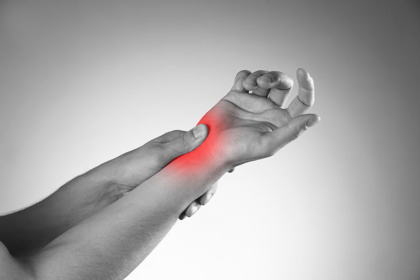Signs & Symptoms
The wrist is frequently injured during sport ranging from acute traumatic fractures (or breaks) in contact sports such as football, hockey and basketball to overuse injuries as in racquet sports, golf and gymnastics.
Overuse Injuries
Wrist pain can occur from repetitive overuse, where an activity involves repetitive wrist motion for long periods without a rest. The soft tissues (muscles and tendons) become inflamed and in extreme cases, a stress fracture of one of the wrist bones can occur. De Quervain’s Syndrome is an overuse injury causing pain at the base of the thumb.
Traumatic Injuries
Traumatic injuries to the wrist most commonly occur with a fall on an outstretched hand causing sprains, strains or even fractures. An X-ray may be recommended if a fracture (or break) is suspected. A fracture can occur at the base of the thumb, known as a “scaphoid fracture”. This type of injury does not always show up initially on X-rays, so it is important to be assessed by a physiotherapist following a traumatic injury, especially if pain is an ongoing issue.
Arthritis
Osteoarthritis is a type of arthritis where the cartilage at the end of the bones in the joint wear away over time. A previous injury like a fracture can leave an individual predisposed to arthritis here.
Rheumatoid Arthritis is an inflammatory condition where the body’s immune system attacks its own soft tissues. It is commonly seen in the wrist joint and can sometimes affect both wrists.
Carpal Tunnel Syndrome
Carpal tunnel syndrome develops when there is compression of the median nerve as it passes through the carpal tunnel on the palm side of the wrist. A burning pain with numbness or pins and needles can be felt in the thumb, index and middle finger and into part of the ring finger. Sometimes nerve conduction studies can be used to confirm the diagnosis and the extent of the compression.
Our Treatment & Expertise
It is essential to determine the cause of your wrist pain. At Bray Physiotherapy, we will complete a thorough assessment of the wrist including active and passive movement, assessing range, strength of the muscles, and stability of the ligaments. We will determine the precise location of the injury and if a fracture is suspected a referral to the hospital will be required.
R.I.C.E. (Rest, Ice, Compression, and Elevation) principles are applied in the first 24-48 hours to reduce inflammation. Once the acute swelling has settled, we aim to restore full movement, strength and stability to the wrist. Our ‘Hands-On’ approach may include massage, manual therapy, electrotherapy and/or acupuncture which will enhance the body’s own healing abilities. Wrist supports, bracing or taping may be used to help stabilise the wrist while it is healing. We pay special attention to posture and ergonomics, and where necessary educate to improve posture and work practices.


